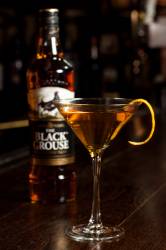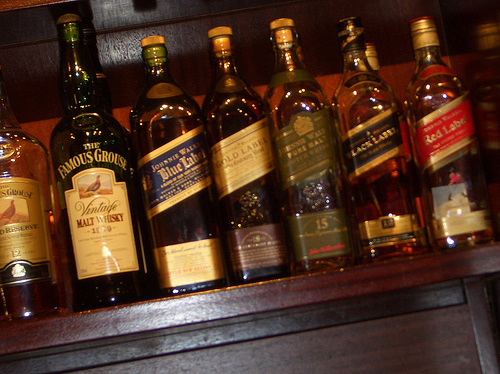 Long time readers of Scotch Addict will probably recognize that I don’t drink many blended Scotch whiskies, as many of my tasting notes are of single malts, but I do enjoy a blend from time to time to add a bit of variety. One of the blends I’m familiar with is The Famous Grouse, close cousins to The Macallan and Highland Park (each is owned by the Edrington Group).
Long time readers of Scotch Addict will probably recognize that I don’t drink many blended Scotch whiskies, as many of my tasting notes are of single malts, but I do enjoy a blend from time to time to add a bit of variety. One of the blends I’m familiar with is The Famous Grouse, close cousins to The Macallan and Highland Park (each is owned by the Edrington Group).
One of the things I was sent was a recipe for the Black and Blue, a drink inspired by barbecue and includes The Black Grouse. The Black Grouse is intended to be a more heavily peated special edition of The Famous Grouse. You’ll note how it’s called the “darker” grouse because of the smokier character and features a black grouse, rather than a red grouse.
The tasting notes read more like an Islay, with a peaty-smoke nose followed by sweetness. The taste features a smoky-sweet tones, hinted by the nose, followed by cocoa and spice. The finish is said to be long, peaty, and aromatic with gentle smokiness. Having never tried the Famous Grouse (yet), I have no basis for comparison but I suspect this popular blends satisfies even the most aggressive of peat lovers.
As an added bonus, The Famous Grouse donates 50p for every bottle sold to the RSPB to help safeguard the 85,000 acres that make up the native habitat of the black grouse.
The Black and Blue
2 ounce The Black Grouse Blended Scotch Whisky
½ ounce calvados (apple brandy)
½ ounce amaretto
¼ ounce Hazelnut Liqueur
All in all a simple recipe created by Beverage Manager Tinika Green and Andrew Duncan, bartender of famed BBQ restaurant Blue Smoke, NY.

